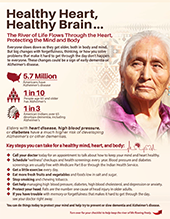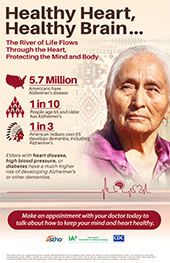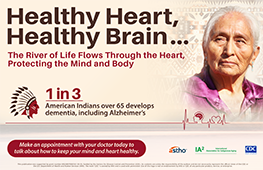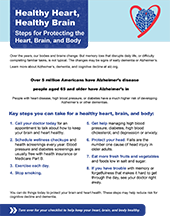Healthy Heart, Healthy Brain
More than six million people in the United States are affected by Alzheimer’s disease, not including other types of dementia, and it’s the fifth leading cause of death for people over 65 years old. A study in California found that 35% of American Indian and Alaskan Native (AI/AN) people who reached 65 years old would develop dementia. That is one out of every three AI/AN elders.
ASTHO, with support from the CDC Alzheimer’s Disease and Healthy Aging Program, partnered with the International Association for Indigenous Aging (IA²) in 2018-2019 to produce a suite of health communication materials to improve quality, availability, and accessibility of public health resources to address the connection between brain health and heart health. All materials are informed by the Healthy Brain Initiative Road Map, and the Road Map for Indian County. The resources on this page comprise the original suite of materials and are available for your use.
In addition, IA² has recently created updated versions of the flyers and posters with additional input from Indigenous people. The revised materials include recent statistics, plain language edits, and updated designs. For your convenience, and in order to encourage and facilitate promotion of these materials, IA² offers printing services.
Program Flyer
 This two-page flyer is intended for American Indian and Alaska Native nations and tribal-serving organizations, healthcare facilities, administrative offices, tribal newspapers/radio stations, and as mailers to tribal members. State and territorial health agencies (S/THAs) are encouraged to work with tribal partners to distribute flyers within these settings and through gatherings such as health fairs, festivals, and other relevant events.
This two-page flyer is intended for American Indian and Alaska Native nations and tribal-serving organizations, healthcare facilities, administrative offices, tribal newspapers/radio stations, and as mailers to tribal members. State and territorial health agencies (S/THAs) are encouraged to work with tribal partners to distribute flyers within these settings and through gatherings such as health fairs, festivals, and other relevant events.
Posters
 |
 |
The vertical and horizontal posters are intended for American Indian and Alaska Native communities and can be posted in senior centers and inter-tribal organizations, healthcare facilities, administrative offices, tribal newspapers/radio stations, and as mailers to tribal members. S/THAs are encouraged to work with tribal partners to disseminate flyers within healthcare offices, senior centers, and through events such as health fairs, festivals, and other relevant affairs.
Editable Flyers
 Two editable versions allow users to add state-specific data and/or images to represent your community. Each version of the template has an accompanying instruction guide. The templates were developed by the Alzheimer's Association as a compliment to the flyers, in partnership with ASTHO and the IA².
Two editable versions allow users to add state-specific data and/or images to represent your community. Each version of the template has an accompanying instruction guide. The templates were developed by the Alzheimer's Association as a compliment to the flyers, in partnership with ASTHO and the IA².
| Editable Text | Editable Text and Images | Instruction Guide |
| Version 1 | Version 1 | Version 1 |
| Version 2 | Version 2 | Version 2 |
Provider Guide
The provider guide is intended to support healthcare providers and administrators to inform and guide their conversations with American Indian and Alaska Native patients about the connections between brain health, including risk factors, protective health behaviors, and key messages. S/THAs are encouraged to use the provider guide internally and to share with provider groups.
Radio Public Service Announcements (PSAs)
Four radio PSAs featuring popular former host of Native American Calling, Harlan McKasato, are available for use on state and regional radio networks. The PSAs will be played on Native American Calling, the nation’s only talk radio show dedicated to Native American views and perspectives. S/THAs are encouraged to work with tribal partners to distribute these PSAs to popular radio stations within their region.
Videos
These brief videos, featuring J. Neil Henderson, PhD, from the University of Minnesota’s Memory Keepers Medical Discovery Team, are intended to be used by tribal-serving hospitals and clinics, tribal senior program directors, tribal media outlets, administrators, and inter-tribal councils. Videos can be played in clinics, senior centers, media outlets, and other appropriate venues. The videos will educate and inform tribal elders and their caregivers, tribal senior program directors, state and tribal health leaders, and others about the relationship between heart and brain health. S/THAs are encouraged to work with tribal partners to identify appropriate placement of the videos.